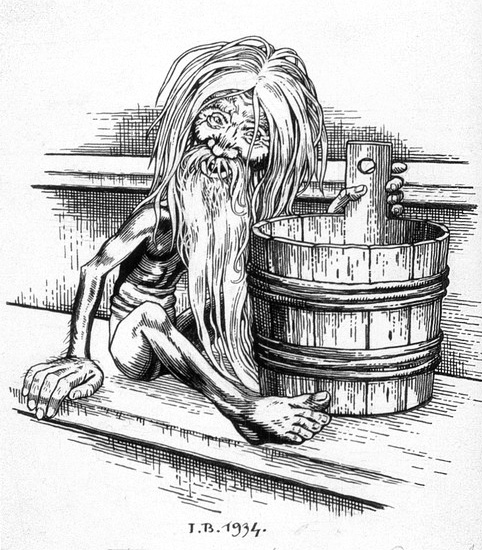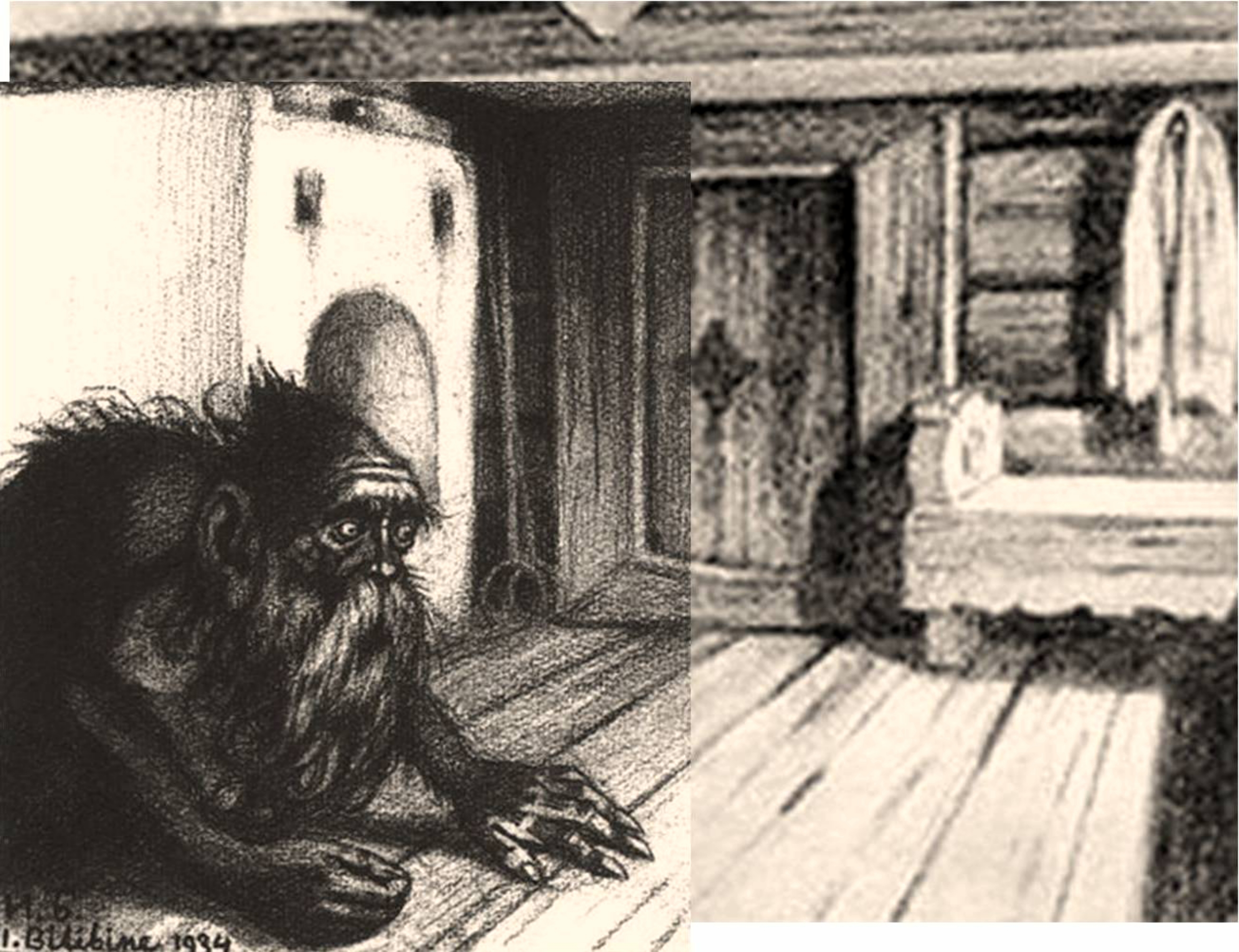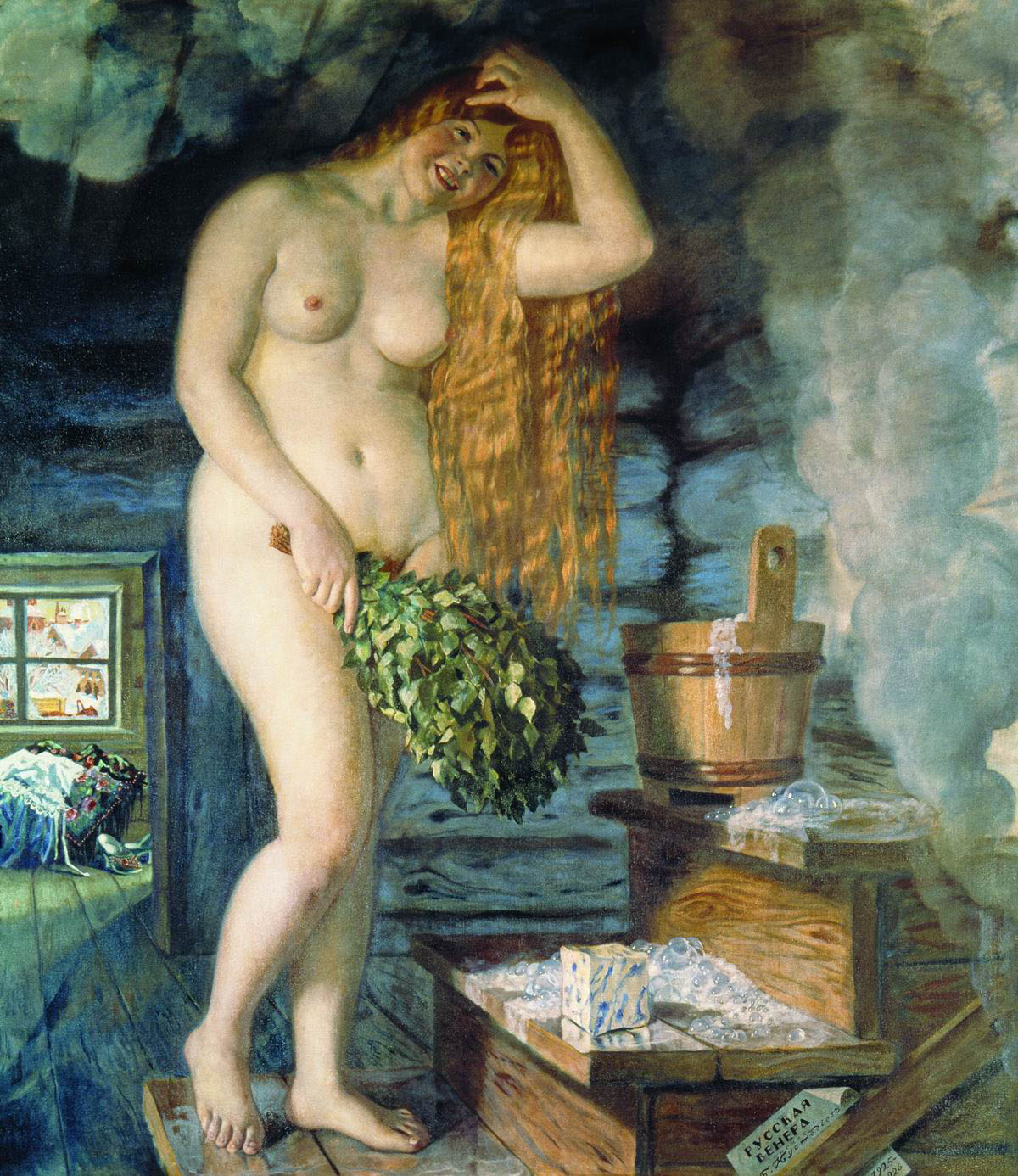|
Bannik
The Bannik () is a bathhouse (''banya'') spirit in Slavic mythology.Alexinsky, G. ''Slavonic Mythology'' in ''New Larousse Encyclopedia of Mythology''. Prometheus Press, 1973, p. 287-88 He is usually described as a small, naked old man with a long beard, his body covered in the birch leaves left over from well used bath brooms. Many accounts also claim that he is a shapeshifter and can appear as a local person to someone who stumbles across him, or even as a stone or coal in the oven heating the bathhouse. Slavic bathhouses resemble saunas, with an inner steaming room and an outer changing room. A place where women gave birth and practiced divinations, the bathhouse was strongly endowed with vital forces. The third firing (or fourth, depending on tradition) was reserved for the bannik, and, given his inclination to invite demons and forest spirits to share his bath, no Christian images were allowed lest they offend the occupants. If disturbed by an intruder while washing, the bann ... [...More Info...] [...Related Items...] OR: [Wikipedia] [Google] [Baidu] |
Domovoy
In the Slavic religious tradition, Domovoy (Russian: Домово́й, literally "he oneof the household"; also spelled ''Domovoi'', ''Domovoj'', and known as pl, Domowik or Serbian and ua, Домовик, translit=domovyk) is the household spirit of a given kin. They are deified progenitors, that is to say the fountainhead ancestors of the kin. According to the Russian folklorist E. G. Kagarov, the Domovoy is a personification of the supreme Rod in the microcosm of kinship. Sometimes he has a female counterpart, Domania, the goddess of the household, though he is most often a single god. The Domovoy expresses himself as a number of other spirits of the household in its different functions. Etymology and belief The term ''Domovoy'' comes from the Indo-European root *''dom'', which is shared by many words in the semantic field of "abode", "domain" in the Indo-European languages (cf. Latin ''domus'', "house"). The Domovoy have been compared to the Roman ''Di Penates'', the '' ... [...More Info...] [...Related Items...] OR: [Wikipedia] [Google] [Baidu] |
Banya (sauna)
A ''banya'' ( rus, баня, p=ˈbanʲə, a=Ru-баня.ogg) is originally a Russian steam bath with a wood stove. It is considered an important part of Russian culture. The bath takes place in a small room or building designed for dry or wet heat sessions. The steam and high heat make the bathers perspire. Genders were traditionally segregated in the ''banya'', with separate rooms for the sexes. In the Russian language, the word ''banya'' may also refer to a public bathhouse, the most historically famous being the Sanduny (''Sandunovskie bani''). History A mention of the ''banya'' is found in the ''Radziwiłł Chronicle'' in the story of Princess Olga's revenge for the murder of her husband, Prince Igor, by the Slavic tribe of Drevlians in 945 AD. The leader of the Drevlians had hopes of marrying the widow Olga and sent messengers to discuss the idea. "When the Drevlians arrived, Olga commanded that a bath should be made ready for them and said, 'Wash yourselves and come to ... [...More Info...] [...Related Items...] OR: [Wikipedia] [Google] [Baidu] |
Bannik
The Bannik () is a bathhouse (''banya'') spirit in Slavic mythology.Alexinsky, G. ''Slavonic Mythology'' in ''New Larousse Encyclopedia of Mythology''. Prometheus Press, 1973, p. 287-88 He is usually described as a small, naked old man with a long beard, his body covered in the birch leaves left over from well used bath brooms. Many accounts also claim that he is a shapeshifter and can appear as a local person to someone who stumbles across him, or even as a stone or coal in the oven heating the bathhouse. Slavic bathhouses resemble saunas, with an inner steaming room and an outer changing room. A place where women gave birth and practiced divinations, the bathhouse was strongly endowed with vital forces. The third firing (or fourth, depending on tradition) was reserved for the bannik, and, given his inclination to invite demons and forest spirits to share his bath, no Christian images were allowed lest they offend the occupants. If disturbed by an intruder while washing, the bann ... [...More Info...] [...Related Items...] OR: [Wikipedia] [Google] [Baidu] |
Akaname
The is a Japanese ''yōkai'' depicted in Toriyama Sekien's 1776 book ''Gazu Hyakki Yagyō'', with its precursor or equivalent documented earlier in 1686. These beings presumably lick the filth and scum that collect in bathtubs and bathrooms. Terminology The word ''aka'' refers to dead skin on a person's body, alongside the dirt, grime, or sweat that may be scrubbed or washed off; the ''aka'' can also refer to scum that accumulates at the bathhouse as a result, including perhaps mildew. Hence the name ''akaname'' means 'scum-licker' or 'filth-licker". There is speculation whether ''aka'' alludes to impurities or defilements of the soul, or negative thoughts known in Buddhism as ''bonnō'' (Sankskrit: '' kleshas''), and the ''yōkai'' may serve as warning not to be so preoccupied with such thoughts as to be derelict in the chores of cleansing the bath of such filth. Another speculation is a possible connection to the sacred water used as offering in Buddhism, known as wate ... [...More Info...] [...Related Items...] OR: [Wikipedia] [Google] [Baidu] |
Ovinnik
The Ovinnik (russian: Овинник), Joŭnik or Jownik ( be, Ёўнік) is a malevolent spirit of the threshing house in Slavic folklore whose name derived from ''ovin'' 'barn'.Dixon-Kennedy, Mike (1998). ''Encyclopedia of Russian and Slavic Myth and Legend''. Santa Barbara, California: ABC-CLIO. p. 212. . He is prone to burning down the threshing houses by setting fire to the grain. To placate him, peasants would offer him roosters and bliny. On New Year's Eve, the touch of an Ovinnik would determine their fortune for the New Year. A warm touch meant good luck and fortune, while a cold touch meant unhappiness. See also * Bannik * Domovoi * Slavic mythology Slavic mythology or Slavic religion is the religious beliefs, myths, and ritual practices of the Slavs before Christianisation, which occurred at various stages between the 8th and the 13th century. The South Slavs, who likely settled in the B ... References Bibliography * * Slavic paganism Slavic tutelary ... [...More Info...] [...Related Items...] OR: [Wikipedia] [Google] [Baidu] |
Public Bathing
Public baths originated when most people in population centers did not have access to private bathing facilities. Though termed "public", they have often been restricted according to gender, religious affiliation, personal membership, and other criteria. In addition to their hygienic function, public baths have also been social meeting places. They have included saunas, massages, and other relaxation therapies, as are found in modern day spas. As the percentage of dwellings containing private bathrooms has increased in some societies, the need for public baths has diminished, and they are now almost exclusively used recreationally. History Public facilities for bathing were constructed, as excavations have provided evidence for, in the 3rd millennium BC, as with the Great Bath, Mohenjo-daro. Ancient Greece In Greece by the sixth century BC men and women washed in basins near places of physical and intellectual exercise. Later gymnasia had indoor basins set overhead, the open ... [...More Info...] [...Related Items...] OR: [Wikipedia] [Google] [Baidu] |
Slavic Mythology
Slavic mythology or Slavic religion is the religious beliefs, myths, and ritual practices of the Slavs before Christianisation, which occurred at various stages between the 8th and the 13th century. The South Slavs, who likely settled in the Balkan Peninsula during the 6th–7th centuries AD, bordering with the Byzantine Empire to the south, came under the sphere of influence of Eastern Christianity, beginning with the creation of writing systems for Slavic languages (first Glagolitic, and then Cyrillic script) in 855 by the brothers Saints Cyril and Methodius and the adoption of Christianity in Bulgaria in 863. The East Slavs followed with the official adoption in 988 by Vladimir the Great of Kievan Rus'. The West Slavs' process of Christianization was more gradual and complicated. The Moravians accepted Christianity as early as 831, the Bohemian dukes followed in 845, Slovaks accepted Christianity somewhere between the years 828 and 863, but the Poles accepted it much later ... [...More Info...] [...Related Items...] OR: [Wikipedia] [Google] [Baidu] |
Bath Broom
Bath broom ( rus, банный веник, p=ˈbanːɨj ˈvʲenʲɪk; fi, vasta or '; et, viht); lt, vanta) is a besom, or broom, used for bathing in saunas, such as Russian banyas. See also * Birching * Venik A broom (also known in some forms as a broomstick) is a cleaning tool consisting of usually stiff fibers (often made of materials such as plastic, hair, or corn husks) attached to, and roughly parallel to, a cylindrical handle, the broomstick. I ... References Further reading *Всё О Бане. Banya Reference Guide Bathing Finnish culture Russian culture {{Tool-stub ... [...More Info...] [...Related Items...] OR: [Wikipedia] [Google] [Baidu] |
Sauna
A sauna (, ), or sudatory, is a small room or building designed as a place to experience dry or wet heat sessions, or an establishment with one or more of these facilities. The steam and high heat make the bathers perspire. A thermometer in a sauna is typically used to measure temperature; a hygrometer can be used to measure levels of humidity or steam. Infrared therapy is often referred to as a type of sauna, but according to the Finnish sauna organisations, infrared is not a sauna. History The oldest known saunas in Finland were made from pits dug in a slope in the ground and primarily used as dwellings in winter. The sauna featured a fireplace where stones were heated to a high temperature. Water was thrown on the hot stones to produce steam and to give a sensation of increased heat. This would raise the apparent temperature so high that people could take off their clothes. The first Finnish saunas were always of a type now called ''savusauna''; "smoke sauna". These diffe ... [...More Info...] [...Related Items...] OR: [Wikipedia] [Google] [Baidu] |
Childbirth
Childbirth, also known as labour and delivery, is the ending of pregnancy where one or more babies exits the internal environment of the mother via vaginal delivery or caesarean section. In 2019, there were about 140.11 million births globally. In the developed countries, most deliveries occur in hospitals, while in the developing countries most are home births. The most common childbirth method worldwide is vaginal delivery. It involves four stages of labour: the shortening and opening of the cervix during the first stage, descent and birth of the baby during the second, the delivery of the placenta during the third, and the recovery of the mother and infant during the fourth stage, which is referred to as the postpartum. The first stage is characterized by abdominal cramping or back pain that typically lasts half a minute and occurs every 10 to 30 minutes. Contractions gradually becomes stronger and closer together. Since the pain of childbirth correlates with contractions ... [...More Info...] [...Related Items...] OR: [Wikipedia] [Google] [Baidu] |
Divination
Divination (from Latin ''divinare'', 'to foresee, to foretell, to predict, to prophesy') is the attempt to gain insight into a question or situation by way of an occultic, standardized process or ritual. Used in various forms throughout history, diviners ascertain their interpretations of how a querent should proceed by reading signs, events, or omens, or through alleged contact or interaction with a supernatural agency. Divination can be seen as a systematic method with which to organize what appears to be disjointed, random facets of existence such that they provide insight into a problem at hand. If a distinction is to be made between divination and fortune-telling, divination has a more formal or ritualistic element and often contains a more social character, usually in a religious context, as seen in traditional African medicine. Fortune-telling, on the other hand, is a more everyday practice for personal purposes. Particular divination methods vary by culture and reli ... [...More Info...] [...Related Items...] OR: [Wikipedia] [Google] [Baidu] |
Christianity
Christianity is an Abrahamic monotheistic religion based on the life and teachings of Jesus of Nazareth. It is the world's largest and most widespread religion with roughly 2.38 billion followers representing one-third of the global population. Its adherents, known as Christians, are estimated to make up a majority of the population in 157 countries and territories, and believe that Jesus is the Son of God, whose coming as the messiah was prophesied in the Hebrew Bible (called the Old Testament in Christianity) and chronicled in the New Testament. Christianity began as a Second Temple Judaic sect in the 1st century Hellenistic Judaism in the Roman province of Judea. Jesus' apostles and their followers spread around the Levant, Europe, Anatolia, Mesopotamia, the South Caucasus, Ancient Carthage, Egypt, and Ethiopia, despite significant initial persecution. It soon attracted gentile God-fearers, which led to a departure from Jewish customs, and, a ... [...More Info...] [...Related Items...] OR: [Wikipedia] [Google] [Baidu] |









